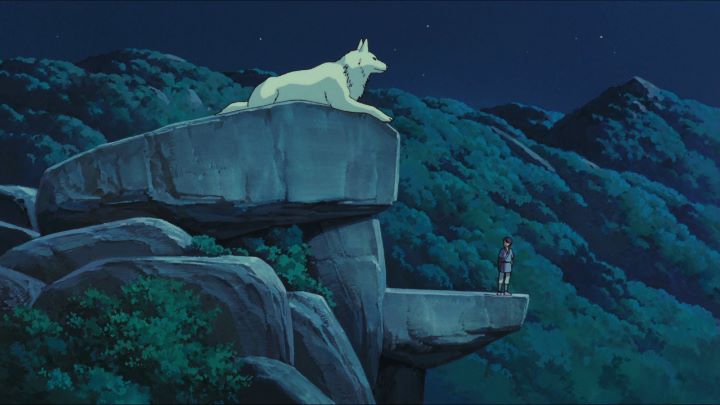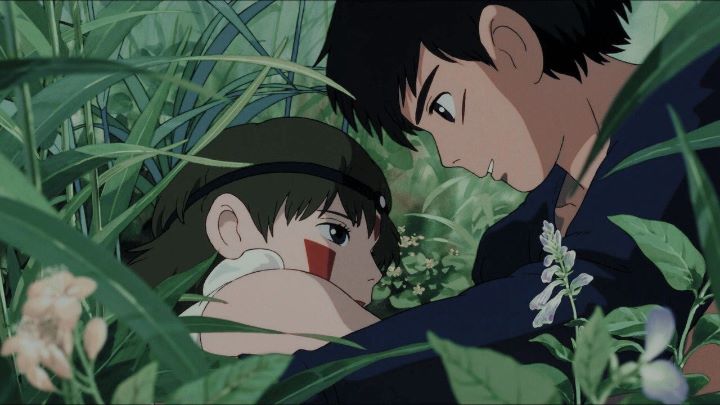










The first time I watched "Princess Mononoke" was actually on cable television. At the time, I was a teenager, and I hadn't heard of Studio Ghibli before. I would watch anime on Friday nights on Canadian channel YTV while doing my homework, not because I loved it, but because I was fascinated with its exotic style and understood it to be cool. Every now and then, the channel would replace the regular 2-4 hours of anime programming with a feature film, also usually anime. In the TV Times schedule, I remember seeing "Princess Mononoke" listed that week, and suspected that it was some girl-targeted fairy tale. You could imagine my surprise when the opening minutes showed a Japanese village, with a male warrior riding bare-back on an elk, shooting arrows at a demon-tentacle-invested boar the size of a house. This isn't like any fairy tale I've seen before. And while I didn't much care for the old bare-foot culture of the citizens that inhabit the movie, I was still fascinated by the originality of the story and its message, the violence, and more than anything, the maturity and respect it had both for itself and for the viewer. There is a reason "Princess Mononoke" is often cited as a number one favorite for most Ghibli fans. It would be the first to receive a timely theatrical release in North America, under Miramax (a Disney-owned company, since the film was a bit too violent to associate directly with Disney's reputation). Ghibli films had found their way to America before, but were so heavily edited to be more "marketable" that they were unrecognizable. Ghibli put their foot down; legend has it that producers wanted to edit "Mononoke," but it response they received a box with a Japanese katana, with a note that simply said "no cuts." The film itself is nothing less than an epic, on par with "The Lord of the Rings" and "Star Wars" in scope and majesty. Studio Ghibli had never really made something like that before. The critical acclaim it received would lead to Disney taking a chance with "Spirited Away," and ultimately their whole catelog. Set centuries ago at the transition of the metal age, dark forces are affecting the guardians of the forest. These forces find their way to the small village where Prince Ashitaka lives. With bow and arrow, he is able to kill the boar possessed by the demon, but not before the demon touches his arm, leaving it infected with black marks that writhe with energy and strength beyond his control. With no choice, he goes through a formal ceremony to banish himself in order to leave the village (here, no one who leaves the forgotten village is allowed to return) and seek the source of the dark magic, and hopefully a cure. His adventure takes him to warring cities, at the heart of which is "Iron Town," a developing city built on its success of mining and forging weaponry, allowing them to better cut down the forests and mountains to claim more resources. The Gods of the forest, made up of massive intelligent wolves, apes and boars, regularly attack the armies of Iron Town to defend their home and keep balance in the world. Askitaka gets wrapped up in all of it, including the peculiar "wolf princess," a human teenager raised by the wolf Gods and eager to fight with her family. Aside from the obvious aesthetic choices based in Japanese culture, some of the concepts are strikingly original. This includes the idea of sentient animals acting as Gods, working along their leader, a silent deer with the face of a man. This includes the cute kodama, spirits who live in the trees. Yes, much of this comes from old legends, but I've never seen it rendered so effectively. Or used so effectively in a memorable setting to convey atmosphere in a larger story. Even among the humans, we have multiple dimensions to all the characters. Lady Eboshi is arguably the antagonist, a fearless woman who will stop at nothing for progress, but does so to care for her town, taking special care and seeing potential in the women and disabled in the village, people who would normally be ignored or disregarded by men. Everyone has flaws and strengths to their character, except perhaps for Ashitaka himself, who is our avatar, a spectator who sees whats wrong and wonders why everyone can't live peacefully for their own sakes. Of course, the underlying message is about man's relationsip with nature, but I don't think I can recall a film that was so effective in making me care about that theme while not overpowering the plot.  It's an exceptionally strong story, and while you should naturally watch this one in its original Japanese dub, I encourage you to also watch the English version at least once. It is given a surprisingly strong translation, thanks to the English script being written by legendary comic and novel writer Neil Gaiman, and a strong American cast of Hollywood voice actors. Most people would laugh, but this is one of my favourite English dubs in a Ghibli movie.Visually, the movie is a new step forward for the studio and their production process. It merges CGI sparingly but effectively, and the traditional animation looks a little more stylized and detailed. It isn't as "clean" as digitally-colored films would be later, but symbolizes the best of its era. The designs of the animal Gods still haunt me to this day. Everything really feels epic, every bit as its story.If you aren't in love with old Japanese culture, you might have trouble appreciating "Princess Mononoke" to its fullest, but then really, why would you consider watching anime at all? On the other hand, this film might change your mind on that. It's one of Studio Ghibli's strongest films, and a proud moment for director Hayao Miyazaki. As lovely as all of their films are, this comes closest to being a true masterpiece.
It's an exceptionally strong story, and while you should naturally watch this one in its original Japanese dub, I encourage you to also watch the English version at least once. It is given a surprisingly strong translation, thanks to the English script being written by legendary comic and novel writer Neil Gaiman, and a strong American cast of Hollywood voice actors. Most people would laugh, but this is one of my favourite English dubs in a Ghibli movie.Visually, the movie is a new step forward for the studio and their production process. It merges CGI sparingly but effectively, and the traditional animation looks a little more stylized and detailed. It isn't as "clean" as digitally-colored films would be later, but symbolizes the best of its era. The designs of the animal Gods still haunt me to this day. Everything really feels epic, every bit as its story.If you aren't in love with old Japanese culture, you might have trouble appreciating "Princess Mononoke" to its fullest, but then really, why would you consider watching anime at all? On the other hand, this film might change your mind on that. It's one of Studio Ghibli's strongest films, and a proud moment for director Hayao Miyazaki. As lovely as all of their films are, this comes closest to being a true masterpiece.